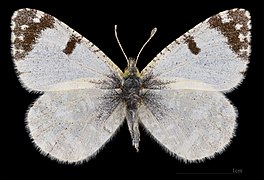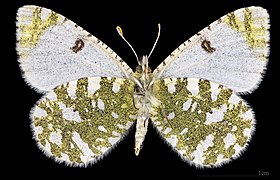Species of butterfly
.mw-parser-output .hidden-begin{box-sizing:border-box;width:100%;padding:5px;border:none;font-size:95%}.mw-parser-output .hidden-title{font-weight:bold;line-height:1.6;text-align:left}.mw-parser-output .hidden-content{text-align:left}You can help expand this article with text translated from
the corresponding article in French. (June 2023) Click [show] for important translation instructions.
View a machine-translated version of the French article.
Machine translation, like
DeepL or
Google Translate, is a useful starting point for translations, but translators must revise errors as necessary and confirm that the translation is accurate, rather than simply copy-pasting machine-translated text into the English Wikipedia.
Consider
adding a topic to this template: there are already 6,002 articles in the
main category, and specifying|topic= will aid in categorization.
Do not translate text that appears unreliable or low-quality. If possible, verify the text with references provided in the foreign-language article.
You must provide
copyright attribution in the
edit summary accompanying your translation by providing an
interlanguage link to the source of your translation. A model attribution edit summary is Content in this edit is translated from the existing French Wikipedia article at [[:fr:Marbré de Lusitanie]]; see its history for attribution.
You should also add the template ((Translated|fr|Marbré de Lusitanie)) to the
talk page.
For more guidance, see
Wikipedia:Translation.
Euchloe tagis, the Portuguese dappled white, is a butterfly in the family Pieridae.
It ranges through southern Europe where it is found from Portugal to northwestern Italy and northern Africa (there are local populations in Morocco and Algeria).
The imago has a black apical patch spotted with white on the forewing upperside, and a black discoid macula. The underside of the hind wings is gray-green, studded with white spots of variable extent.
This species is found in local, discrete populations limited to fairly small areas of suitable habitat which is invariably made of calcareous outcrops with Mediterranean scrubland where the food plants, crucifers of the genus Iberis are found.
The species flies from February to June, in a single generation. It winters at the chrysalis stage.
-
Euchloe tagis bellezina ♂
-
Euchloe tagis bellezina ♂ △
-
Euchloe tagis castillana ♂
-
Euchloe tagis castillana ♂ △




